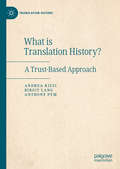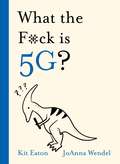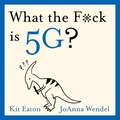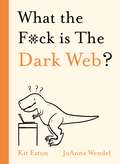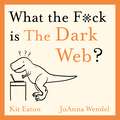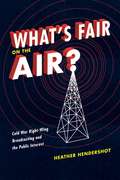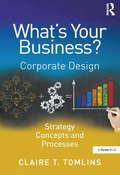- Table View
- List View
What Your Boss Really Wants from You: 15 Insights to Improve Your Relationship
by Steve ArnesonTake Charge of the Relationship That Matters Most to Your Career Your most important work relationship is with your boss. You need it to go well. But even the best bosses can be hard to read, and some seem downright inscrutable. Your boss isn&’t going to change for you—don&’t waste your time trying. The solution lies in figuring out what makes your boss tick and adapting your own work style to make the relationship better. But how do you do that? In this pragmatic and accessible guide, top executive coach Steve Arneson shows how to find the answers to fifteen essential questions that will help you understand your boss&’s leadership style, goals, motivations, work relationships, and how he or she sees you. Vivid real-world examples demonstrate Arneson&’s advice in action and show clearly how this process can be used to gain a more meaningful, productive, and enjoyable work life.
What a Boy Wants
by Nyrae DawnIf you adore Jennifer E. Smith's The Statistical Probability of Love at First Sight and Jessica Park's Flat-Out Love, you'll love this book.Courtesy of watching his mom's relationships, Sebastian Hawkins knows what girls need to do to get a guy. He has what he considers a PHD in hooking up. When he needs extra cash for a car, Sebastian starts up an online venture as The Hook-up Doctor, to anonymously help girls land the guy of their dreams. Of course, his services don't offer a happily-ever-after guarantee. He's seen firsthand getting together never means staying together. And then he falls in love... With the last girl he would expect...Totally not in his game plan. Suddenly, Sebastian finds himself muddled in the game he's always prided himself on. He can't even pick up girls at parties anymore! Why would anyone want to be in love when it turns you into a stuttering, screwed-up, mess with really lame stalker tendencies? Stalking? Totally not his gig. But the Hook-up Doctor won't let himself go down easily. He's always known how to give a girl what she wants and now it's time to figure out what a boy wants... and he definitely plans on getting it.A companion novel to What a Boy Needs.
What are you Reading?: The World Market and Indian Literary Production
by Pavithra NarayananThis book offers a material critique on various aspects of Indian literary production and its reception by its audiences. Taking a historical and contemporary lineage into account, the author variously discusses the social, political, and economic factors that impact upon and determine choices in the publishing world. Examining the constructions of the archive of postcolonial works by Indian writers in relation to nationalist histories, language wars, and the relationship between economic policies and literature, the book forcefully argues that why we read what we read is more than coincidental. Placing the rights of minoritized and disadvantaged communities at the heart of the analysis of India’s decolonization and industrial projects, the book attempts to address not just inequalities in the publishing world, but also social inequities engendered by global capitalism. Offering a critique of academics who act as cultural gatekeepers of intellectual production, the book finally underscores the disconnect between the academic theory and practice of scholars of postcolonial studies who argue against inequality and marginalization while simultaneously supporting hegemonic academic practices. This book will be of interest to scholars of development studies, cultural studies, literature, postcolonial studies, economics, and those studying globalization, as well as the interested lay reader.
What is Journalism?
by Chris NashThis book argues that journalism should treat itself as an academic discipline on a par with history, geography and sociology, and as an art form in its own right. Time, space, social relations and imagination are intrinsic to journalism. Chris Nash takes the major flaws attributed to journalism by its critics--a crude empiricism driven by an un-reflexive 'news sense'; a narrow focus on a de-contextualised, transient present; and a too intimate familiarity with powerful sources--and treats them as methodological challenges. Drawing on the conceptual frameworks of Pierre Bourdieu, David Harvey, Henri Lefebvre, Michel-Rolph Trouillot and Gaye Tuchman, he explores the ways in which rigorous journalism practice can be theorised to meet these challenges. The argument proceeds through detailed case studies of work by two leading iconoclasts--the artist Hans Haacke and the 20th century journalist I. F. Stone. This deeply provocative and original study concludes that the academic understanding of journalism is fifty years behind its practice, and that it is long past time for scholars and practitioners to think about journalism as a disciplinary research practice. Drawing on an award-winning professional career and over three decades teaching journalism practice and theory, Chris Nash makes these ideas accessible to a broad readership among scholars, graduate students and thoughtful journalists looking for ways to expand the intellectual range of their work.
What is Translation History?: A Trust-Based Approach (Translation History)
by Anthony Pym Birgit Lang Andrea RizziThis book presents a dynamic history of the ways in which translators are trusted and distrusted. Working from this premise, the authors develop an approach to translation that speaks to historians of literature, language, culture, society, science, translation and interpreting. By examining theories of trust from sociological, philosophical, and historical studies, and with reference to interdisciplinarity, the authors outline a methodology for approaching translation history and intercultural mediation from three discrete, concurrent perspectives on trust and translation: the interpersonal, the institutional and the regime-enacted. This book will be of particular interest to students and scholars of translation studies, as well as historians working on mediation and cultural transfer.
What the Children Said: Child Lore of South Louisiana (Cultures of Childhood)
by Jeanne Pitre SoileauWinner of the 2022 Opie PrizeJeanne Pitre Soileau vividly presents children’s voices in What the Children Said: Child Lore of South Louisiana. Including over six hundred handclaps, chants, jokes, jump-rope rhymes, cheers, taunts, and teases, this book takes the reader through a fifty-year history of child speech as it has influenced children’s lives.What the Children Said affirms that children's play in south Louisiana is acquired along a network of summer camps, schoolyards, church gatherings, and sleepovers with friends. When children travel, they obtain new games and rhymes and bring them home. The volume also reveals, in the words of the children themselves, how young people deal with racism and sexism. The children argue and outshout one another, policing their own conversations, stating their own prejudices, and vying with one another for dominion. The first transcript in the book tracks a conversation among three related boys and shows that racism is part of the family interchange. Among second-grade boys and girls at a Catholic school, another transcript presents numerous examples in which boys use insults to dominate a conversation with girls, and girls use giggles and sly comebacks to counter this aggression.Though collected in the areas of New Orleans, Baton Rouge, and Lafayette, Louisiana, this volume shows how south Louisiana child lore is connected to other English-speaking places: England, Scotland, Ireland, Australia, and New Zealand, as well as the rest of the United States.
What the F*ck is 5G? (WTF Series)
by Kit EatonWhat the f*ck is 5G, and how does it even work?The world loves 4G phones, tablets and other gizmos and we take the tech for granted...but when that 4 grew up into the next-gen 5, it seems everyone perked up and started caring about phone networking tech. Journalists journaled, politicians, er, politicked, and tin-foil hat wearers reached for the extra-thick reinforced foil. Why all this fuss? Believe it or not, 5G could change the way you live. Because though it seems like smartphones are only good for tiktok and texting, 5G has the power to revolutionise how we interact with public spaces - from concerts and gigs to coffee shops, paving the way for foundational tech like virtual and augmented reality. This book will explain this missing radio link that will propel us into the future of self-driving cars and VR. Oh, and along the way we'll explore why 5G and coronavirus are very definitely and completely, utterly, not the same thing
What the F*ck is 5G? (What the *&%^)
by Kit EatonWhat the f*ck is 5G, and how does it even work?The world loves 4G phones, tablets and other gizmos and we take the tech for granted...but when that 4 grew up into the next-gen 5, it seems everyone perked up and started caring about phone networking tech. Journalists journaled, politicians, er, politicked, and tin-foil hat wearers reached for the extra-thick reinforced foil. Why all this fuss? Believe it or not, 5G could change the way you live. Because though it seems like smartphones are only good for tiktok and texting, 5G has the power to revolutionise how we interact with public spaces - from concerts and gigs to coffee shops, paving the way for foundational tech like virtual and augmented reality. This book will explain this missing radio link that will propel us into the future of self-driving cars and VR. Oh, and along the way we'll explore why 5G and coronavirus are very definitely and completely, utterly, not the same thing
What the F*ck is 5G? (What the *&%^)
by Kit EatonWhat the f*ck is 5G and how does it work?The world loves 4G phones, tablets and other gizmos and we take the tech for granted...but when that 4 grew up into the next-gen 5, it seems everyone perked up and started caring about phone networking tech. Journalists journaled, politicians, er, politicked, and tin-foil hat wearers reached for the extra-thick reinforced foil. Why all this fuss? Believe it or not, 5G could change the way you live. Because though it seems like smartphones are only good for tiktok and texting, 5G has the power to revolutionise how we interact with public spaces - from concerts and gigs to coffee shops, paving the way for foundational tech like virtual and augmented reality. This book will explain this missing radio link that will propel us into the future of self-driving cars and VR. Oh, and along the way we'll explore why 5G and coronavirus are very definitely and completely, utterly, not the same thing.(P) 2021 Hodder & Stoughton Ltd
What the F*ck is The Cloud? (WTF Series)
by Kit EatonWhat the f*ck is the Cloud, and how does it even work?Ah, The Cloud. It's such a useful bit of tech jargon isn't it? The kind that's casually thrown around in work meetings by bosses who (kind of) understand and maybe even at the nerdier type of dinner or drinks parties. People joke about the cloud while others take it for granted and some worry about this mysterious entity where all of our data is stored, accessible at the touch of a screen from anywhere on Earth. But what even is the cloud, and for that matter, where is the cloud?Join us on a journey from the very first iterations of the internet that we know and (sometimes) love, all the way through thorny issues of data collection and storage (weren't we all fooled by the 'ten years on' social media trend, even as we rely on cloud-stored photos of cats to cheer us up?) and discover the mysterious place where The Cloud ominously hovers.
What the F*ck is The Cloud? (WTF Series)
by Kit EatonWhat the f*ck is the Cloud, and how does it even work?Ah, The Cloud. It's such a useful bit of tech jargon isn't it? The kind that's casually thrown around in work meetings by bosses who (kind of) understand and maybe even at the nerdier type of dinner or drinks parties. People joke about the cloud while others take it for granted and some worry about this mysterious entity where all of our data is stored, accessible at the touch of a screen from anywhere on Earth. But what even is the cloud, and for that matter, where is the cloud?Join us on a journey from the very first iterations of the internet that we know and (sometimes) love, all the way through thorny issues of data collection and storage (weren't we all fooled by the 'ten years on' social media trend, even as we rely on cloud-stored photos of cats to cheer us up?) and discover the mysterious place where The Cloud ominously hovers.
What the F*ck is The Cloud? (WTF Series)
by Kit EatonWhat the f*ck is the the Cloud and how does it work?Ah, The Cloud. It's such a useful bit of tech jargon isn't it? The kind that's casually thrown around in work meetings by bosses who (kind of) understand and maybe even at the nerdier type of dinner or drinks parties. People joke about the cloud while others take it for granted and some worry about this mysterious entity where all of our data is stored, accessible at the touch of a screen from anywhere on Earth. But what even is the cloud, and for that matter, where is the cloud?Join us on a journey from the very first iterations of the internet that we know and (sometimes) love, all the way through thorny issues of data collection and storage (weren't we all fooled by the 'ten years on' social media trend, even as we rely on cloud-stored photos of cats to cheer us up?) and discover the mysterious place where The Cloud ominously hovers.(P) 2021 Hodder & Stoughton Ltd
What the F*ck is The Dark Web? (WTF Series)
by Kit EatonWhat the f*ck is the Dark Web, and how does it even work?Whether it's from dodgy acronym-titled crime shows to news stories designed to terrify you down to your socks we've all heard about sites like Silk Road and the ways criminals use cryptocurrency online. But did you know that among the various shady corners of the dark web you can also find portals to the BBC and Facebook?The thing is even the way the everyday internet works is a mystery to us and its darkest corners are, of course, more deeply shrouded. So, let's go on a journey from the birth of the Net through the strangest dark services - need a hitman to bump off your superfluous...er...beloved spouse? - to the surprisingly positive uses of dark technology, including dodging the watchful eye of oppressive censors.Over half of us can't remember a time before the internet - and for the rest it's increasingly difficult to imagine life without the damn thing! It's about time we understood more about it and we can start with the question: What The Fuck is The Dark Web?
What the F*ck is The Dark Web? (WTF Series)
by Kit EatonWhat the f*ck is the Dark Web, and how does it even work?Whether it's from dodgy acronym-titled crime shows to news stories designed to terrify you down to your socks we've all heard about sites like Silk Road and the ways criminals use cryptocurrency online. But did you know that among the various shady corners of the dark web you can also find portals to the BBC and Facebook?The thing is even the way the everyday internet works is a mystery to us and its darkest corners are, of course, more deeply shrouded. So, let's go on a journey from the birth of the Net through the strangest dark services - need a hitman to bump off your superfluous...er...beloved spouse? - to the surprisingly positive uses of dark technology, including dodging the watchful eye of oppressive censors.Over half of us can't remember a time before the internet - and for the rest it's increasingly difficult to imagine life without the damn thing! It's about time we understood more about it and we can start with the question: What The Fuck is The Dark Web?
What the F*ck is The Dark Web? (WTF Series)
by Kit EatonWhat the f*ck is the dark web and how does it work?Whether it's from dodgy acronym-titled crime shows to news stories designed to terrify you down to your socks we've all heard about sites like Silk Road and the ways criminals use cryptocurrency online. But did you know that among the various shady corners of the dark web you can also find portals to the BBC and Facebook?The thing is even the way the everyday internet works is a mystery to us and its darkest corners are, of course, more deeply shrouded. So, let's go on a journey from the birth of the Net through the strangest dark services - need a hitman to bump off your superfluous...er...beloved spouse? - to the surprisingly positive uses of dark technology, including dodging the watchful eye of oppressive censors.Over half of us can't remember a time before the internet - and for the rest it's increasingly difficult to imagine life without the damn thing! It's about time we understood more about it and we can start with the question: What The Fuck is The Dark Web?
What the People Know: Freedom and the Press
by Richard ReevesDiscusses the press and how it does and doesn't work and what needs to happen to improve things.
What to Do When You're New: How to Be Comfortable, Confident, and Successful in New Situations
by Keith RollagBlending stories and insights with simple techniques and exercises, this invaluable guide for the introvert will get you out of your comfort zone and trying new things in no time.Whether you&’re changing jobs, joining a group, or moving to a new city, putting yourself out there in new situations is no picnic. Being forced to introduce yourself, having to ask questions among strangers, learning expectations of those around you--it&’s not fun for anyone! However, when we let our worries stop us from getting familiar with our surroundings and learning the dos and don&’ts of our new environment, we seriously hinder our progress, joy, and the opportunities that await us.In What to Do When You're New, you can discover the necessary skills to learn how to:Overcome fearsMake great first impressionsTalk to strangers with easeGet up to speed quicklyConnect with people wherever you goThis book combines the author's research and firsthand experience from having to adjust to a job transfer to Japan with that of leading scientists to explain why we are so uneasy in new situations--and how we can learn to become more confident and successful newcomers.
What to Say Next: Successful Communication in Work, Life, and Love—with Autism Spectrum Disorder
by Sarah Nannery Larry NanneryUsing her personal experience living as a professional woman with Autism Spectrum Disorder, Sarah Nannery, together with her husband, Larry, offers this timely communication guide for anyone on the Autism spectrum looking to successfully navigate work, life, and love. When Sarah Nannery got her first job at a small nonprofit, she thought she knew exactly what it would take to advance. But soon she realized that even with hard work and conscientiousness, she was missing key meanings and messages embedded in her colleagues&’ everyday requests, feedback, and praise. She had long realized her brain operated differently than others, but now she knew for sure: she had Autism Spectrum Disorder (ASD). With help from her neurotypical partner—now husband—Larry, mostly in frantic IM chats, Sarah rose to Director of Development at one of the world&’s largest nonprofits. Together they have tackled challenges in how Sarah navigates personal and professional relationships, how they navigate marriage and parenthood, all of which are differently challenging for someone with ASD. But she wonders, at times, how life would be different if she&’d had to figure it all out herself. So, in What to Say Next, she offers advice, empathy, and straightforward strategies from her own tool-kit—not only for others who see the world differently, but for their families, partners and colleagues. In What to Say Next, Sarah breaks down everyday situations—the chat in the break room, the last-minute meeting, the unexpected run-in—in granular detail, explaining not only how to understand the goals of others, but also how to frame your own. Larry adds his thoughts from a neurotypical perspective, sharing what was going on in his brain and how he learned to listen and enlighten, while supporting and maintaining Sarah&’s voice. At a time when more and more people are being diagnosed with ASD—especially women and girls—this book tells important truths about what it takes to make it in a neurotypical world, and still be true to yourself.
What to Say to Get Your Way: The Magic Words that Guarantee Better, More Effective Communication
by John BoswellA guidebook of simple conversational swaps that reveals how to have more productive conversations.Have you ever heard that sticks and stones will break your bones “but words will never hurt you”? Whoever coined that phrase didn’t get it right. Words do hurt, and words matter. The words you choose can cause misunderstandings, destroy deals, and break up marriages.Take one simple example: someone says, “You’re wrong.” Immediately you feel on the defensive and are much more likely to respond aggressively. But suppose that instead the other party had said, “I’d argue that . . .” or “I’d make the case that . . .” Either one of these simple substitutions all but guarantees a much more reasoned response.What to Say to Get Your Way is filled with simple tricks and specific examples of communications that are kinder and gentler, and much more effective, than the first thing that might come out of your mouth. It is a tool for helping you get your point across in a way that can be heard—and even appreciated.
What to Talk About: On a Plane, at a Cocktail Party, in a Tiny Elevator with Your Boss's Boss
by Rob Baedeker Chris Colin Tony MillionaireHomo sapiens have been speaking for hundreds of years--and yet basic communication still stymies us. We freeze up in elevators, on dates, at parties, under Dumpsters. We stagger through our exchanges merely hoping not to crash, never considering that we might soar. We go home sweaty and eat a birthday cake in the shower.But no more. With What to Talk About you'll learn to speak--fluently, intelligently, charmingly--to family, friends, coworkers, lovers, future lovers, horse trainers, children, even yourself. This hilarious manual, written by two award-winning authors and illustrated by legendary cartoonist Tony Millionaire, is tailor-made for anyone who might one day attend a dinner party, start a job, celebrate a birthday, graduate from school, date a human, or otherwise use words.What to Talk About is not rocket science, but it is a lot like brain surgery, in the sense that is terrifying, risky--and could change you forever.
What to Talk About: With Friends, With Strangers, With Your Aunt's Boyfriend, Greg!
by Rob Baedeker Chris ColinLearn to navigate the perils of everyday awkwardness with this smart, funny and charmingly illustrated guide.Homo sapiens have been speaking for thousands of years—and yet basic communication still stymies us. We freeze up in elevators, on dates, at parties, and just about everywhere else. We stagger through our exchanges merely hoping not to crash, never considering that we might soar. But no more. With What to Talk About you’ll learn to speak—fluently, intelligently, charmingly—to family, friends, coworkers, lovers, future lovers, horse trainers, children, even yourself. This hilarious manual, written by two award-winning authors and illustrated by legendary cartoonist Tony Millionaire, is tailor-made for anyone who might one day attend a dinner party, start a job, celebrate a birthday, graduate from school, date a human, or otherwise use words.What to Talk About is not rocket science, but it is a lot like brain surgery, in the sense that is terrifying, risky—and could change you forever.
What's Fair on the Air?: Cold War Right-Wing Broadcasting and the Public Interest
by Heather HendershotThe rise of right-wing broadcasting during the Cold War has been mostly forgotten today. But in the 1950s and ’60s you could turn on your radio any time of the day and listen to diatribes against communism, civil rights, the United Nations, fluoridation, federal income tax, Social Security, or JFK, as well as hosannas praising Barry Goldwater and Jesus Christ. Half a century before the rise of Rush Limbaugh and Glenn Beck, these broadcasters bucked the FCC’s public interest mandate and created an alternate universe of right-wing political coverage, anticommunist sermons, and pro-business bluster. A lively look back at this formative era, What’s Fair on the Air? charts the rise and fall of four of the most prominent right-wing broadcasters: H. L. Hunt, Dan Smoot, Carl McIntire, and Billy James Hargis. By the 1970s, all four had been hamstrung by the Internal Revenue Service, the FCC’s Fairness Doctrine, and the rise of a more effective conservative movement. But before losing their battle for the airwaves, Heather Hendershot reveals, they purveyed ideological notions that would eventually triumph, creating a potent brew of religion, politics, and dedication to free-market economics that paved the way for the rise of Ronald Reagan, the Moral Majority, Fox News, and the Tea Party.
What's Your Book?: A Step-by-Step Guide to Get You from Inspiration to Published Author
by Brooke WarnerWhat's Your Book? is an aspiring author&’s go-to guide for getting from idea to publication. Brooke Warner is a publishing expert with thirteen years&’ experience as an acquiring editor for major trade houses. In her book, she brings her unique understanding of book publishing (from the vantage point of coach, editor, and publisher) to each of the book's five chapters, which include understanding the art of becoming an author, getting over common hurdles, challenging counterproductive mindsets, building an author platform, and ultimately getting published. Brooke is known for her straightforward delivery, honest assessments, and compassionate touch with authors. What's Your Book? contains the inspiration and information every writer needs to publish their first or next book.
What's Your Business?: Corporate Design Strategy Concepts and Processes
by Claire T. TomlinsWhat’s Your Business? offers a comprehensive pathway through the subject of corporate design clarifying the relationship between corporate design and corporate strategy and the terms identity, brand, image, communication and reputation. The book explores the impact of developing digital technology on brand creation and positioning in a marketplace, through symbolic and coherent design. A local market trader may buy a van, promote his business on a blackboard and proclaim ’daily special offers’. Corporations use computers, design websites and communicate with global clients through social media. Yet each business started with an idea and developed a distinctive existence. What’s Your Business? helps you turn a business idea into reality by establishing its existence, ethos, message and activities. By integrating corporate and design strategy with creative inputs Claire Tomlins illustrates the subject’s diversity. She ensures businesses set goals, strategies and plans whilst ensuring they recognise an identity that sparks the corporate design strategy and creative inputs that manifests the company’s aesthetic for marketing purposes; including design management, Intellectual Property topics and measures. Business people wishing to know how design can provide added value to their organisation will find this book useful, including where they could contribute. Academic concepts and definitions are updated and explanations are provided to business and design students on where each of their skillsets can contribute to a business.
What's the Buzz? for Primary Students: A Social and Emotional Enrichment Programme
by Mark Le Messurier Madhavi Nawana ParkerWhat’s the Buzz? is an internationally renowned series of programmes designed to help children and young people develop social and emotional awareness. Now available in a revised second edition, What’s the Buzz for Primary Students is a sixteen-lesson programme targeting everyday social challenges faced by primary aged children, such as peer pressure and bullying style behaviours; competition and handling disappointment; feelings and wellbeing and self-awareness. Each lesson is designed around the SAFE criteria (Sequenced; Active; Focused; Explicit) and includes: A new and beautifully illustrated ‘Archie’ story, in which the popular character faces a new and relatable social challenge A series of lively and exciting games and activity suggestions Role-plays and discussion points so that children can put their skills into practice in a supportive environment Having already proven to appeal to teachers and support staff, counsellors and psychologists worldwide, this resource is suitable for anybody looking to enrich the social lives of children. Resources and training modules to support this book can be found on the website www.whatsthebuzz.net.au.




